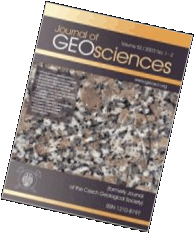 Export to Mendeley
Export to MendeleyOriginal paper
Thermodynamic properties of kaatialaite, Fe[AsO2(OH)2]3·5H2O
Journal of Geosciences, volume 69 (2024), issue 4, 225 - 229
DOI: http://doi.org/10.3190/jgeosci.399
Kaatialaite, Fe[AsO2(OH)2]3·5H2O, is a rare ferric arsenate that precipitates from strongly acidic solutions. In general, it is found associated with arsenolite, scorodite, and sulfur. In this work, we used acid-solution calorimetry and relaxation calorimetry to determine the enthalpy of formation and entropy, respectively, of kaatialaite. The experimental values are ΔfHo = -4223.3±7.4 kJ·mol-1 and So = 559±9 J·mol-1·K-1. Combining these values yields ΔfGo -3518.4±7.9 kJ·mol-1 and log Ksp = -65.46 for the dissolution reaction Fe(H2AsO4)3·5H2O = Fe3+ + 6H+ + 3AsO43- + 5H2O. The accuracy of the results can be tested by geochemical modeling with an aqueous solution from the Svornost mine in Jáchymov. Some of the droplets there precipitate kaatialaite actively. The modeling shows that the solution is in redox disequilibrium and is initially supersaturated with respect to arsenolite, but not to kaatialaite. Increasing the redox potential in the simulation leads to the switch of the saturation indices and explains crystallization of kaatialaite upon slow oxidation of the aqueous As(III) to As(V). The model also predicts that the stable ferric arsenate is scorodite, not kaatialaite. Considering the crystal structures of both phases, however, it shows that the assembly of the kaatialaite structure requires much less deprotonation and is, therefore, not kinetically hindered.
Webdesign inspired by aTeo. Hosted at the server of the Institute of Petrology and Structural Geology, Charles University, Prague.
ISSN: 1803-1943 (online), 1802-6222 (print)
email: jgeosci(at)jgeosci.org


IF (WoS, 2024): 1.3
5 YEAR IF (WoS, 2024): 1.4
Policy: Open Access
ISSN: 1802-6222
E-ISSN: 1803-1943